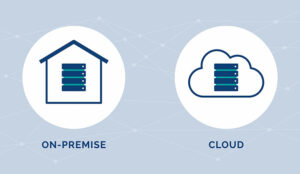Triana Atallah of Business Systems argues the case for migrating to a cloud contact centre.
Why Implement Cloud Contact Centre Technology?
It’s a reality that COVID-19 caused contact centres worldwide to struggle as they attempted to implement efficient remote-working solutions for their contact centre agents.
Implementation needed to happen fast and made many businesses realised that a cloud contact centre offered scalability and operational efficiency in addition to remote working.
And as a second wave of the virus threatens to make an appearance, contact centres need to remain prepared and ensure their systems and processes are in place to cope for another potential lockdown.
There are many reasons as to why now is the right time to make a move to a cloud based call centre solution, just like the four reasons below.
1. Empower Agents With a Modern-Day Cloud Contact Centre Solution
According to research carried out by ContactBabel, only 26% of 2019’s UK contact centre survey respondents had some form of homeworking capability with only 3.8% of UK agents actually being based at home.
Fast forward to 2020 and we’ve seen a widespread accelerated focus to home working across all industries. And for many, it has worked well.
For some, homeworking has been credited with reducing agent attrition and offering greater staff flexibility with 55% of UK contact centres citing this as the most important benefit to homeworking so far – according to a separate ContactBabel report.
Remote working is a topic, particularly within the contact centre space that will continue to divide opinions. And understandably so as traditionally, the contact centre space has always been a physical workplace with agents sitting side by side answering calls with Managers/Team Leaders supervising.
However, in a post-pandemic world where homeworking is no longer an unknown, and has been tried and tested by the majority, organisations will struggle to attract quality agents if they do not offer their employees homeworking and agent flexibility in some form or another.
In fact, according to ICMI statistics, working from home means an 80% better retention rate for contact centre agents.
As many organisations will have realised during the lockdown, cloud contact centre technology offers flexibility for employees which are far greater than an on-premise system.
For starters, the technology is browser-based so agents can access the system wherever they are.
Secondly, homeworking has provided employees with more flexibility over their working hours and home life, delivering increased satisfaction for the employee which in turn will result in an marked improvement in customer service as agents strive to demonstrate their ability to work from home.
2. Achieve Long Term Cost Savings with Cloud Contact Centre software
Moving to a cloud contact centre means more flexibility in staffing, supplier management and business continuity arrangements which can amount to long term cost savings:
- Cloud contact centre technology means organisations are easily set up for remote working. Remote working in turn allows contact centres to widen their recruitment pool by looking for agents in other geographic locations and are not limited by the area proximity which the contact centre resides in.
- As cloud software easily supports remote working, this can also reduce the need to find additional physical office space for when the business expands.
- Moving to the cloud also means contact centres can support a more volume-driven staffing schedule. For example, remote workers can log on for short shifts when they are needed (based on how busy the contact centre is) rather than the full eight hours which agents might normally work.
- Cloud contact centre technology easily allows for the ability to scale agents up or down according to seasonality. This can be based upon the requirements of the business throughout the year and eliminates the need to purchase licenses outright.
- For multi-site operations, moving to the cloud offers the opportunity to have a single-cross-site management team with call routing and self-service controlled at a single point. This means management costs are reduced and infrastructure/processes held in the cloud will avoid issues which an on-premise call centre solution can experience, such as work duplication across sites.
- Lastly, a cloud solution means organisations can consolidate multiple suppliers into fewer, or even a single supplier to manage the contact centre infrastructure, PBX and telecom services. This reduces the time being spent on supplier management
3. There Are Many Benefits of a Unified Contact Centre Solution
Communications these days now need to be kept consistent across multiple channels, working together seamlessly to provide a unified customer experience.
A cloud based based contact centre solution can help achieve just this, where communications, systems and processes can be managed in one space, making it easier for the contact centre to navigate from webchat, to SMS to phone calls to any other channel.
Take the example of Gant Travel – a corporate Travel Management company based in America. Gant Travel were struggling with a siloed contact centre.
This meant no visibility across channels, increased call handling time and customer friction. By implementing cloud call centre technology, they were able to:
- Develop a custom dashboard for agents to access customer profiles
- Integrate their cloud call centre solution with Salesforce so the relevant customer profile data was pulled into the system as soon as there is an incoming call
- Improve their Interactive Voice Response Technology (IVR) which included eliminating unnecessary options which were causing customer frustration
4. Plan for Contact Centre Disaster Recovery with Cloud Contact Centre Software
Cloud based contact centre models ensure business continuity and disaster recovery in the following ways:
- Cloud solutions enable agents to be connected to the technology platform and necessary applications from anywhere, with the only requirement being access to the Internet. With an on-premise system, if disaster strikes and agents need to work from home, getting set up to work remotely can be much harder and as a result have an impact on the customer experience during this critical time.
- As many cloud solutions are equipped with clustered data centres in different regions, this ensures that even in an outage, if the primary system were to go down, the next available interaction can be delivered by the next available data centre in a fully replicated model. Cloud solutions are run in an active-active model to ensure service failover is as seamless as possible. This allows companies to maintain their availability to service and sell, avoiding what could be a disastrous turn for the organisation, where the inability to service and sell could result in lost revenue, negative customer experiences and a high number of interactions dropped.
- Cloud solutions also eliminate the time-intensive and costly process of building and maintaining a back-up site to deal with emergency situations. With a cloud solution, business continuity and disaster recovery can be delivered from multi-site locations.
Extra Tip: Cloud solutions can also provide backup reserve disaster recovery protection to contact centres who have an on-site customer premise equipment (CPE) model.
This allows for organisations to become more familiar with offsite functionality and hardware but at a slower pace.
It can lead to a greater commitment further down the line to relocate the primary functionality into the cloud once the original contact centre technology is at end of life.
Why is it Important to Consider Cloud Contact Centre Technology?
During the upheaval which the global pandemic has caused, understandably some organisations may be hesitant to invest in new technology.
However, although it may be tempting to remain with the familiar, it’s important to remember that innovation and change can be a good thing, particularly when looking to drive competitive differentiation in the contact centre industry.

Triana Atallah
Many contact centres may have been thrown into the world of cloud and remote working the last few months, and it may have happened a lot quicker than many of us would have expected.
However, witnessing so many operations moving within days to a remote working environment whilst still supporting customers during this challenging time is proof that a cloud contact centre’s disaster recovery and business continuity advantages should not be overlooked.
Author: Guest Author
Published On: 11th Aug 2020 - Last modified: 19th Jul 2022
Read more about - Guest Blogs, Business Systems



































